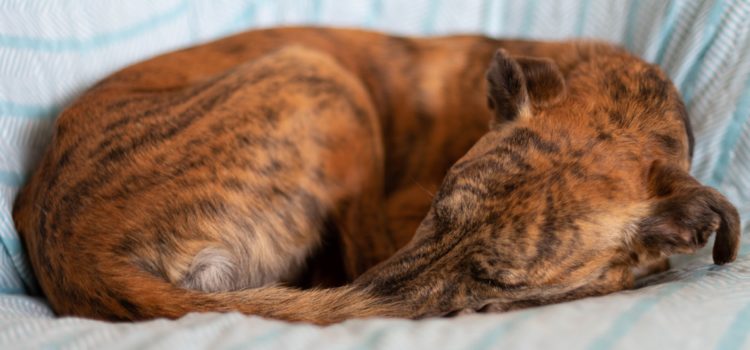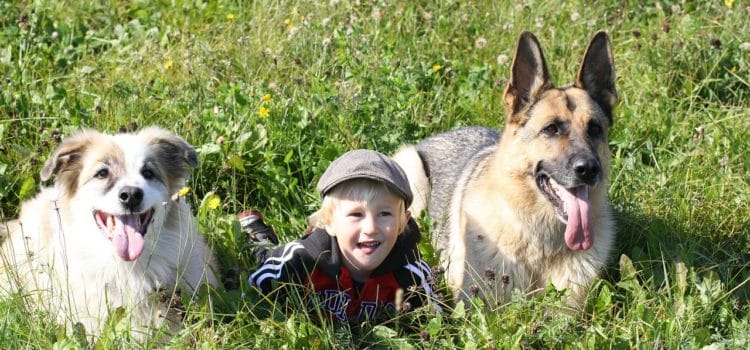”My dog stressed??!! … Never, they live in paradise, they have fallen with their little butts in butter, they live in absolute luxury.” It is phrases we hear often, but dogs are more part of our household and social activities than ever before and we unwittingly place more and more demands on them, without teaching them how to cope and adapt.
We expose them to so many different situations, different environments, people and other animals. We take them to flea-markets, the beach, attend large training classes or highly charged agility or sports training – expose them to crowds of people and other dogs and expected them to deal with the immense level of noise, activities and stimulation. When we take our dogs on walks, they are expected to ignore all other dogs, smells, birds, humans and other objects whizzing past such as cyclist and joggers and if they don’t, we give a quick jerk on the lead; which in turn leads to even more stress.
They are expected to ‘just cope’ and we assume that they are sociable to everybody, all dogs and situations and that they are to be emotionally stable and well behaved regardless of what we expose them to.
All dogs respond to certain situations differently. Some might find a particular situation stressful while another might enjoy it. Exposing a timid or shy dog to lots of people and other dogs on the beach, because you want to socialize her can cause the dog immense stress (and at the same time decrease any positive associations you were hoping for). This dog might enjoy a quiet walk in the forest or field. For a jolly and outgoing dog, going to the beach and meeting different people and other dogs, is an enjoyable outing.
Stress is not always a bad thing; dogs (and humans) need a certain amount of stress to learn, function and survive. Stress raises the blood pressure and increases the heart rate. Hormonal activity provides the body with extra energy to sustain the flight/fight response which is vital for survival. If another dog or situation threatens your dog, your dog needs to activate his flight/fight response in order to survive/get to safety/defend himself. The intensity of the response is dependant on the severity of the threat or the ‘perceived’ threat, previous learning in similar situations and the dog’s temperament. This type of stress is called positive stress or eustress.
However…if the dog is experiencing chronic stress or is frequently exposed to stress-causing triggers and the dog is not given a long recovery phase (such as rest) so-called adaptation diseases such as kidney, bladder, skin and cardiovascular diseases are to be expected. (It is exactly the same for us humans.)
When a dog experiences acute stress the following physiological response happens. In short, the brain and pituitary glands releases the ACT hormone. This stimulates the adrenal cortex to increase the production of corticosterone and cortisol. The adrenal medulla then produces adrenaline and nor-adrenaline that increases heart rate and blood pressure. It constricts certain blood vessels to increase blood flow to the muscles and brain, while decreasing blood to the digestive system and internal organs. This then prepares the dog for fight/flight response. It also stimulates the liver to increase glucose into the blood therefore giving the heart, muscles and brain the energy the dog needs for the impending response.
Long-term stress causes over-production of cortisol inside the body. Cortisol regulates the wake-sleep pattern, regulation of warmth, regulation of blood pressure and respiration, control of food intake, fat metabolism and water balance. This permanently raised level of cortisol in the system inhibits the building of protein in the lymphocytes, resulting in a reduced number of defense cells, which weakens the immune system. It causes diseases of the digestive system such as stomach ulcers, indigestion and gastritis. Heightened levels of cortisol disturb the water balance in such a way that diarrhea or increased urination occurs. It also suppresses the maturing of ova or spermatozoa in the sex glands, which is important to know for breeders. In the long run it can lead to serious damage of the adrenal glands. Adrenaline accelerates circulation and respiration that in addition to an increased pulse rate also manifest it self in the dog panting excessively.
Long term stress can lead to raised sex hormone levels and therefore lead to a lower aggressive behaviour threshold, impulsivity and irritability.
Below are only few symptoms that might indicate that your dog is suffering from stress. Some signs of stress and frustration may be more difficult to detect while others are unmistakable. You may notice that some signs relate to an increase in activity while other relate to a decrease in activity. Please take note that some of the symptoms could have medical causes and you should always consult your veterinarian.
Symptoms need to be observed and interpreted in context in which they appear i.e. a dog could be panting because it is hot, he has just been playing or because he is experiencing stress. Another indication is the frequency and intensity of the behaviour/symptom. Usually more than one symptom will appear at the same time.
~ Lack of focus and attention while interacting or training
~ Biting and tugging on the leash i.e. during training, crowed areas, or at the vet
~ Sweaty paws
~ Hyperactivity, unable to settle down
~ Over reaction to triggers normally not reacted to, or not with such intensity
~ Relapses in an allready housetrained dog
~ Self mutilation i.e. chewing a paw or tail, excessive grooming
~ Sleeping excessively or a disturbed sleep pattern
~ Chronic skin disorders such as allergies (due to weakened immune system)
~ Bad coat condition, dripping nose, bald patches
~ Excessive moulting during a particular context i.e. at shows, vet, grooming parlour
~ Compulsive behaviours
~ Urinates more frequently in a particular context (male and femle)
~ Continuous diarrhea
~ Destructiveness
~ Loss of appetite or not eating his favourite treat in a particular context
~ Over eating (gulping down food), also eating non-edible objects such as stones, paper, wood
~ Unpleasant body odor and breath (due to over secretion of gastrointestinal acids)
~ Excessive panting
~ Shivering (as if getting cold)
~ Displacement behaviours (behaviours that are happening out of context)
~ Withdrawn and passive
Situations that can cause stress in our dogs:
~ Direct threats towards the dog (by humans or other dogs)
~ Inconsistent rules, no clear boundaries
~ Violence, anger in the environment even if it not directed at the dog (humans fighting in the house)
~ Physical punishment, jerking on the lead, pushing him down, pulling him along, alpha rolls
~ Restricted movement i.e. kept in kennel, tied down on chain, kept in small rooms such as a laundry room.
~ Too high demands in training and daily life; expecting too much too soon
~ Sudden changes in routine and environment i.e. longer working hours, moving house, kenneling, new baby in the house, new pet
~ Grooming parlours (noises, strange dogs and humans, kennels etc.)
~ Bad weather such as thunder, lightning, strong wind
~ Loss of a human or canine companion
~ Too much exercise for you puppy or adult dog
~ Too rough and too long play sessions in the park with other dogs
~ Not enough time to sleep or being disturbed while trying to sleep
~ Too little exercise and activity for dogs
~ Hunger, thirst
~ Not having access to his toilet area when he needs it
~ Getting cold or being too hot
~ Pain and illness (HD, arthritis, injuries, trauma, shock)
~ A female dog in season in close proximity. It is stressful for the males and stressful for the female trying to ward off overbearing males
~ Loss of senses in the older dog
~ Too much noise i.e. children playing and the dog cannot escape to a quiet area.
~ Being alone for too long with no stimulation, separated from their humans
~ Constant sudden scary situations (i.e. builders next door)
~ Dogs in-house that do not get along with each other, one is constantly trying to get away or creeping around each other or constantly displaying threatening behaviour towards each other.
Things that we can do to reduce the stress levels for our companions:
~ Keep routines or change them gradually, give the dog time to adapt
~ Stop using harsh methods for training and handling. Train your dog obedience by using positive, gentle and humane methods and have realistic expectations.
~ Avoid putting a dog in a situation of hunger, thirst, cold, extreme heat
~ Give him access to his toilet area
~ Find a balance in his exercise and activity routine
~ Give your dog enough time to sleep during the day
~ Provide him with his own ‘safe’ space where he can retreat to should the environment be to noisy or stressful.
~ After excitable periods your dog should be given ample time to rest and relax. Excitable situations can be training, agility, schutzhund training, playing in the park with other dogs, a trip to the beach, after family has visited etc.
~ When you have visitors, go out with your dog, or do any other activity with him, watch him for signs of stress. This way you will know if he really enjoys the activity with you or if it stresses him.
~ When entering new environments, allow the dog time to investigate at his own pace, let him sniff around, only then will he feel more secure i.e. a new training area, at the vet, the groomer, or when taking your dog to friends or a dog-friendly restaurant.
~ Let your dog be part of the social group as much as possible, and only gradually teach him to accept time on his own
~ Be consistent in your interactions with the dog (same rules every day)
~ If you are not sure if something is too much for your dog to handle, stop or shorten the duration or get away from the situation.
~ When getting another pet for your home, consider your current pet’s temperament.
All dogs (as do humans) react differently to particular situations but with the help of the information above you can now easily determine if your dog is feeling comfortable in a particular situations or if he feels a little stressed or is very stressed out.
Sometimes certain stressors are going to be unavoidable. If they do occur, give your dog ample time to ‘de-stress’ afterwards to allow the chemicals in the body to go back to normal levels.
It is import to identify symptoms and know how to prevent stress in our dogs’ lives if we want them to be physically healthy and behaviorally sound.
Copyright Claire Grobbelaar




Leave a Reply